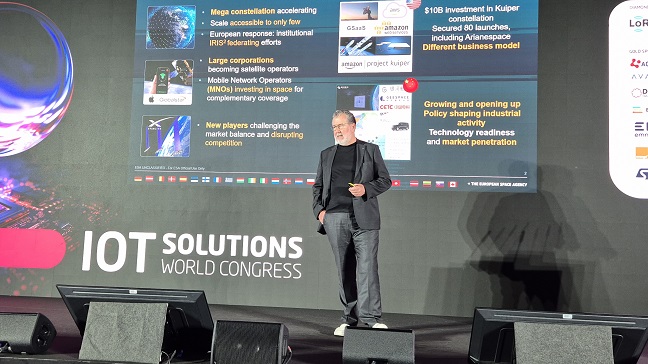LIVE FROM IOT SOLUTIONS WORLD CONGRESS, BARCELONA: The European Space Agency (ESA) believes direct-to-device (D2D) could prove a shot in the arm for the satellite industry, providing access to the economies of scale from consumer device sector needs and consequently improving the market dynamics for the IoT.
Xavier Lobao, head of the Future Telecom Programmes division at the ESA (pictured), explained the satellite sector faced barriers in cracking the broader communications sector due to its niche status.
Efforts to deliver voice and SMS directly to consumer devices, therefore, is like finding “the holy grail”, he said.
By removing the need for dedicated satellite terminals with specific antennas, D2D addresses an issue of unit volume, making the entire connectivity play more affordable by providing access to cheaper devices.
“All of a sudden, if we are able to connect to these kind of devices, consumer devices, directly from satellite, then we have found a fantastic solution,” the ESA expert said.
The potential market is huge: Lobao predicted satellite connections to hit 63 billion by 2029, including IoT, 14 billion of which he expects to be in Europe and the majority in Asia, the Middle East and Africa.
Lobao explained the voice and messaging focus of current D2D initiatives is helpful, but expects the biggest impact of the development to be felt in the industrial IoT segment, “in particular in the automotive sector”.
He believes such connectivity will become fundamental to delivering fully autonomous vehicles, but welcomed the so-called space race around basic D2D connectivity which is now underway involving the likes of SpaceX’s Starlink, Amazon’s Project Kuiper, AST SpaceMobile and others, with competition fuelling technological advances but, crucially also unlocking some much-needed investment.
Solar flair
Ultimately, Lobao expects the D2D race to be about broadband connectivity rather than the voice and messaging services currently envisaged.
He foresees a role for satellites in providing universal broadband coverage, but explained achieving this requires close collaboration with standards bodies including 3GPP to bring its work on terrestrial networks together with the efforts of the ESA and others on non-terrestrial options.
“Our focus from the ESA is through open standards”.
“We are an innovation agency, we focus on the technology. We see that there are some critical enablers, we can provide voice connectivity, we can provide emergency messages easily”.
The next steps may be harder, but Lobao believes they will happen and could be pivotal to future space exploration, enabling interplanetary communications where satellites are employed as “relay stations” in place of current base stations.
Lobao believes the IoT will be a key enabler in emerging space-based industries, making work on providing the connectivity a necessity rather than science fiction.
